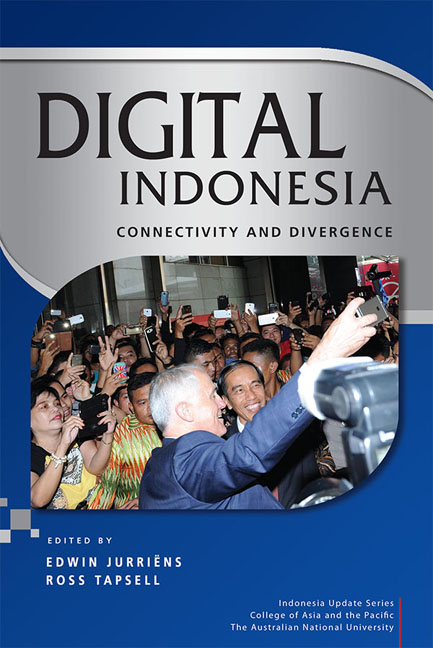Book contents
- Frontmatter
- Contents
- Tables
- Figures
- Contributors
- Acknowledgments
- Glossary
- Map of Indonesia
- 1 Challenges and opportunities of the digital ‘revolution’ in Indonesia
- PART 1 CONNECTIVITY
- PART 2 DIVERGENCE
- 5 Narrowing the digital divide
- 6 Laws, crackdowns and control mechanisms: digital platforms and the state
- 7 The state of cybersecurity in Indonesia
- PART 3 IDENTITY
- PART 4 KNOWLEDGE
- PART 5 COMMERCE
- Index
- Indonesia Update Series
5 - Narrowing the digital divide
from PART 2 - DIVERGENCE
Published online by Cambridge University Press: 12 January 2018
- Frontmatter
- Contents
- Tables
- Figures
- Contributors
- Acknowledgments
- Glossary
- Map of Indonesia
- 1 Challenges and opportunities of the digital ‘revolution’ in Indonesia
- PART 1 CONNECTIVITY
- PART 2 DIVERGENCE
- 5 Narrowing the digital divide
- 6 Laws, crackdowns and control mechanisms: digital platforms and the state
- 7 The state of cybersecurity in Indonesia
- PART 3 IDENTITY
- PART 4 KNOWLEDGE
- PART 5 COMMERCE
- Index
- Indonesia Update Series
Summary
This chapter reviews both government and community efforts to provide better internet access to Indonesia's rural areas and villages. Increasing internet penetration, and narrowing the digital divide, has considerable potential to increase economic growth in Indonesia. In low- and middle-income countries, it has been estimated that each 10 per cent increase in high-speed broadband penetration delivers a 1.38 per cent increase in per capita GDP growth (World Bank 2009: 45; ITU 2012: 5). The availability of internet access in rural areas has been identified as a key factor in development (Puskakom UI 2015: 2).
The majority of internet users in Indonesia live in the western region of the country, especially Java, where internet penetration has reached 36.9 per cent of the population (Puskakom UI 2015: 8). About 83 per cent of internet users live in urban areas, but even within Indonesia's largest cities there is a digital divide between those who have regular access to the internet (less than 20 per cent of urban dwellers) and those who do not (over 80 per cent). Indonesia is a ‘mobile-first’ country, with almost 85 per cent of current internet users accessing the internet on a mobile device (Puskakom UI 2015: 24). The best cellular access is in the cities and the worst in rural areas and villages; providing wireless mobile phone coverage in rural areas is difficult because of the necessity to design systems that can overcome physical obstacles such as mountainous terrain. Given that 46.7 per cent of Indonesians live in rural areas (BPS 2014a), increasing the country's internet penetration will require a greater focus on rural villages. However, building expensive infrastructure for small populations in isolated areas is not economically feasible from a commercial operator's point of view.
The Indonesian mobile market has exploded over the past half-decade. In a country with a population of 250 million, cellular subscriptions stand at 326.3 million, meaning that many people own more than one mobile phone. We Are Social claims that 85 per cent of Indonesians own a mobile phone and 43 per cent own a smartphone (Balea 2016). The internet is largely operated by the private sector, and does not rely on significant funds from government budgets. There are more than 300 commercial internet service providers (ISPs) in Indonesia.
- Type
- Chapter
- Information
- Digital IndonesiaConnectivity and Divergence, pp. 75 - 92Publisher: ISEAS–Yusof Ishak InstitutePrint publication year: 2017

